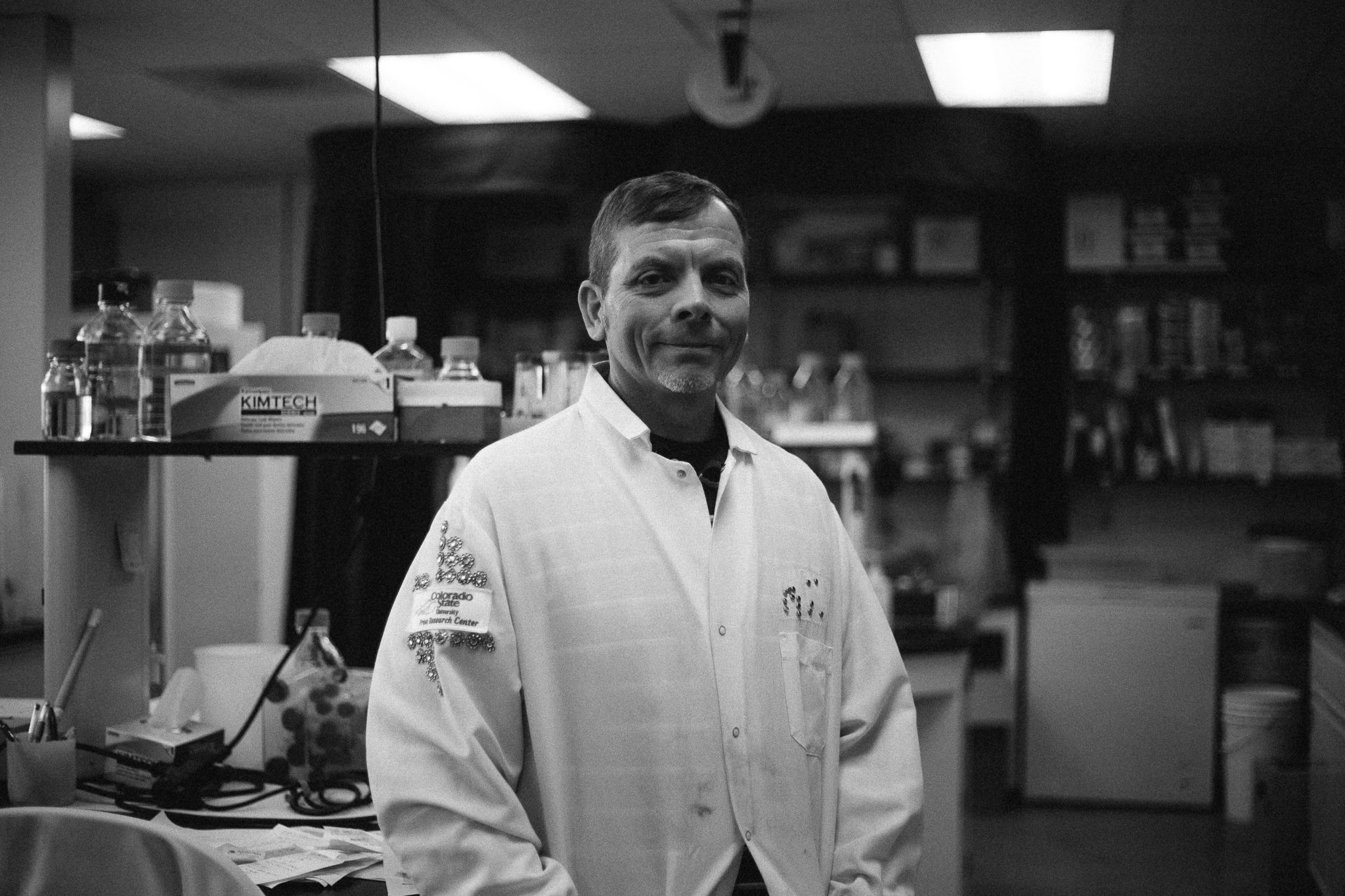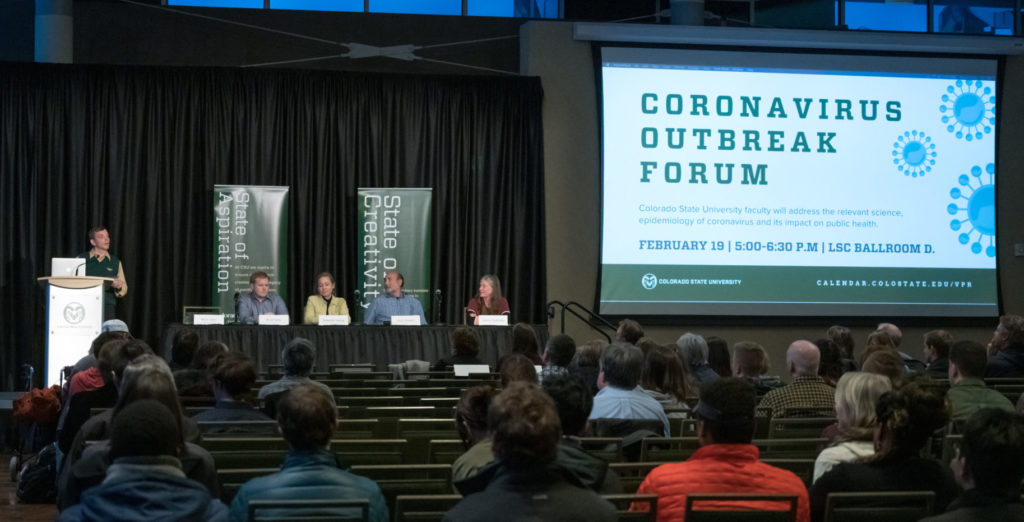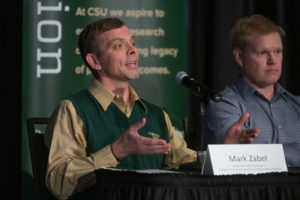
The “Conversation” pairs two people from different areas to the college to talk about the “why” of what they do. In this edition, we feature a chat with Michael Young, research assistant and lab manager for CSU’s Ebel Laboratory, and Mark Zabel, professor of prion biology and immunology and the associate dean for research in the College of Veterinary Medicine and Biomedical Sciences. He is also one of the founders of Science on Tap, a CSU organization dedicated to making science accessible to the public. This interview took place on Jan. 30, 2020, before the novel coronavirus outbreak became a pandemic.

Michael Young: We’ve been asked to talk about basic science today. I was wondering if you can start us off by providing a definition.
Mark Zabel: I prefer the term “foundational science” to “basic.” Basic science sounds dull and unimportant, whereas foundational science really captures the idea that the discoveries we make form the basis for all of the applied sciences. Foundational science is the point of discovery.
Young: Is it fair to say that the general public has more of an appetite for applied science than foundational science?
Zabel: I think so, because applied connotes a practical use for our discoveries, and that really resonates with the general public.
Young: People want cures, they want vaccines …
Zabel: Exactly. They see it impacting their everyday lives. I think that’s why they have a better understanding or connection to the applied science, without really understanding where that information comes from or how we use it to make progress.
Young: You recently became the associate dean for research in CVMBS. What is the college doing in terms of foundational science that you’re really excited about?
Zabel: Microbiome research is starting to explode worldwide as a result of next-generation sequencing. I’ll give you a current example – the outbreak of a novel coronavirus in China. Foundational science asks: Where did this virus come from? How does it relate to the other viruses we already know about? Within weeks, the scientific community sequenced the entire genome of the novel strain and determined its relatedness to other coronaviruses. We quickly had a foundational understanding of its source and what mutations may have occurred to make it pathogenic. That’s a great example of next-gen sequencing and microbiome research informing our understanding of immune responses and then vaccine development.

Young: You established your prion research laboratory at CSU in 2005. Can you give an example of how foundational science has led to advances in prion biology?
Zabel: We’ve spent a lot of time understanding the foundational science behind prions in the environment. Do prions stick to soil or plants? Do they move through water? Do they stay on decomposing carcasses that are infected with prions? We realized that prions really like to stick to clay particles, and they can move through water, but typical municipal processes for cleaning wastewater trapped the prions. That foundational work that’s been going on for almost 15 years is now informing best practices for state wildlife agencies and municipal landfills that need to dispose of cervid carcasses infected with chronic wasting disease.
Advice to undergrads
Young: Say I’m a freshman undergrad and I’m starting to learn a little about foundational versus applied science, and foundational is where I want to be. What is your advice to someone just getting started in their education or career?
Zabel: Find your passion and follow it. Find a foundational researcher and don’t be shy. Show up at their office and say, ‘I’ve read your research and I’m wondering if you could use some help from an undergraduate student.’ The faculty at CSU are very open to training the next generation of young investigators, but sometimes they have full labs, so my other advice is don’t be discouraged. Be persistent.
Young: That was my experience as an undergrad. I knocked on a few doors and the third one opened.
Zabel: Right. Ultimately, you will find a home and you will find investigators who are willing to mentor you.
Finding funding
Young: Do you find it’s harder to find receptive audiences for foundational research as opposed to applied research?
Zabel: It’s a tricky thing to navigate because our first priority is to address the government agencies that fund our work, but that money comes from the taxpayer. It’s been a passion of mine for several years to bring that story to the general public – the people who ultimately fund the work we do – so they understand the relevance of studying prions in the environment or sequencing virus genomes. If we want the public to buy into our work, then we need to make the link between the science that affects their daily lives and the foundational science that we do behind the scenes.
Young: Is funding a problem? As a society, are we not investing in this research anymore?
Zabel: We are, but not at the rates we used to. In the 1980s, the National Institutes of Health budget was big enough to fund about 25 percent of proposals. There’s a natural break there. If you can fund the top quarter of proposals, that’s probably the best science out there. Now only 8 to 10 percent of proposals are funded, so there’s a lot of good foundational science that is going unfunded. The NIH budget increases incrementally, if at all, while the cost of living and the cost of doing the science continues to go up, so our effective budgets have drastically decreased.
“Who could have predicted?”
Young: What’s the long-term cost of that funding decrease?
Zabel: It’s very hard to estimate or extrapolate, but we can look backward and wonder if this or that grant wasn’t funded then where would we be now? For example, foundational researchers discovered bacteria living in extremely hot sea vents where we didn’t think life could exist. They asked how does this work? What kind of proteins do they have that allow them to survive?
Young: That’s Taq polymerase.
Zabel: And that’s the foundation for next-gen sequencing. All of these discoveries start building on each other so that now we’ve been able to sequence a novel virus that has caused a global pandemic. This information was vital to understanding where the virus came from and how it would spread.
Young: Because researchers were looking at thermal vents a decade ago.
Zabel: Who could have predicted that looking at thermal vents would lead to new genetic toolkits that allow huge groundbreaking discoveries? It always goes back to foundational science. Another area of foundational in our college that is Sue Bailey’s partnership with NASA to look at the effects of long-term space habitation on our DNA. She studied the Kelly twins who were both astronauts and identical twins
Young: One stays on Earth; one goes up into space.
Zabel: Right. And she has found some really interesting data on the ends of their chromosomes, the telomeres. Those ends can tell us a lot about the aging process. They’re like caps that protect the interior parts of those chromosomes from damage, but as we age the caps get smaller and so the protection wanes. Sue showed that while in space those telomeres actually lengthened.
Young: Fountain of youth? A hundred miles straight up?
Zabel: Perhaps, but unfortunately the fountain of youth only lasts if you stay up there because once Scott Kelly came back to Earth within a few months his telomeres shortened. That is foundational. What does it all mean now? Who knows? But as we build more research, more data, we ask new questions based on that and then we can start building a picture of what what our telomeres mean, what are those biochemical processes, what our cells do without gravity. And that could really inform how we deal with space travel and space occupancy in the future.
Taking science to the people
Young: I can imagine the public being really interested in “CSU is researching anti-aging treatments” and it’s a harder pitch if they’re investigating the mechanism of telomere extension. What sorts of outreach have you done to bring messages like this into the community?
Zabel: Science on Tap is my baby. That is a big effort that myself and several graduate students started and continue to support today. Our mission is to bring information about science and research to the taxpayer so they can understand what we do and why it’s important. There are other important outreach efforts, too. CSU Speaks and CSU Writes are two avenues our graduate students are using to communicate science to fellow students and to a wider audience.

We have several science outreach events in the college: CVMBS Research Day, the University sponsors Celebrate Undergraduate Research and Creativity, Graduate Student Showcase. The Women in Science Network combines communication of science with advocating for women and other underrepresented groups. Those are a few examples of impactful grassroots efforts.
Young: You talked about following your passion which is great advice so I want to bring the conversation back to something I know you’re passionate about—the role of prions as they play out in yeast as opposed to mammalian organisms. I know you’re a fan of Reed Wickner’s paper on the discovery of prions in yeast. Can you talk about that a bit in the context of foundational versus applied science?
But back to the prions
Zabel: Reed Wickner’s paper is one of my favorite papers ever because of its simplicity, its elegance, its impact, and the fact that there is one author on that paper which you never see anymore. Dr. Wickner started basically with a thought experiment based on this emerging story from the founding father of prions, the generator of the prion hypothesis, Stanley Prusiner. Prusiner put himself out on a limb and said: “I think I’ve discovered a new pathogen but this pathogen is unlike any other pathogen.”
Young: It contradicts the central dogma of molecular biology. It was radical when he proposed it.
Zabel: Exactly. It has no genome. According to the prion hypothesis, this pathogen can replicate without a genetic blueprint. That was completely heretical given that only 30 or 40 years prior Francis and Crick had cracked the genetic code. So for someone to come out just a few decades later and say here’s this caveat, well people just weren’t buying it. Reed Wickner was following this debate and it made him think about other aspects of yeast biology. This is where foundational science gets really interesting because you would never think you’d have a connection between these weird infectious agents that are causing diseases in humans and livestock and the simplest eukaryotic organism—yeast. But Wickner was thinking about another sticky problem in yeast genetics–
Young: Non-Mendelian factors in how they were propagating themselves.
Zabel: Exactly. There are a few genetic elements in yeast that can be passed on from one yeast cell to another but they weren’t passed on in the same way that other genetic components are passed on in normal yeast cells or any other cell type. And that had confounded yeast geneticists for decades. Reed was thinking about this and if it is possible that these genetic elements are encoding information not through genes but through some other mechanism. He didn’t know what that mechanism might be, but he started researching it. Foundational science. This is him alone with petri dishes of yeast.
Young: If all of your sheep are dying of some mysterious disease and somebody is out there staring at petri dishes full of yeast…
Zabel: You’re going to say, “What are you doing? You’re wasting my time here. My sheep are dying.” But Reed was the first scientist to entertain the idea of information that could be encoded and transferred based on the structure of the molecule rather than the sequence of the molecule.
And so that was the big thought breakthrough for Reed and that developed into a hypothesis. He said, if that’s true, I can predict how these genetic elements will be propagated and passed onto other cells. And when he made those predictions based on this hypothesis that it’s not a gene but the shape of a protein, then it matched what he was seeing in his laboratory on these plates. And so that was a huge breakthrough because it not only solved the problem of how are these genetic elements being propagated without these Mendelian ratios but also lent credibility to this brand new hypothesis that Stan Prusiner was talking about in terms of mammalian infectious disease and biochemistry.
And in a completely different very simple unicellular organism. When you can make that leap from something as simple as yeast to something as complex as mammals and the data all support your hypothesis . . . Wow. That’s two huge questions solved in a handful of simple experiments that took less than six months.

Young: That’s elegant. That’s amazing.
Zabel: I love the fact that it was Wickner starting out with a thought experiment, sitting down with a few plates, and then solving these two huge mysteries of science in two completely unrelated fields. It really propelled our understanding of genetics and propelled the foundations of the prion hypothesis.
Young: And if you’re trying to study prions, to come up with a cure for CWD, for example, now you can study it in a fast-growing, easy-to-manipulate model organism as opposed to mouse experiments which are slow to cook, or going into cervids which take even longer. That speeds up the rate at which research proceeds because of a foundational discovery.
Zabel: I can tell you that even today people who study these protein misfolding diseases or prion diseases still use yeast because it is such a great genetic and biochemical tool to isolate those protein misfolding events not just for prion disease but now they’re using yeast to model human protein misfolding diseases.
Young: Amyloid plaques, Alzheimer’s, Parkinson’s.
Zabel: Exactly. All of these can be modeled in yeast and can be propagated in hours rather than months and you can get to foundational biochemical underpinnings of these diseases. So now we’re translating foundational work in yeast to a whole category of human diseases.